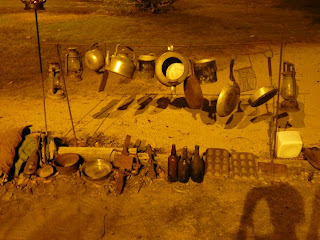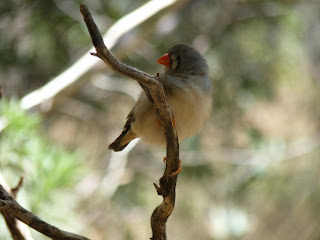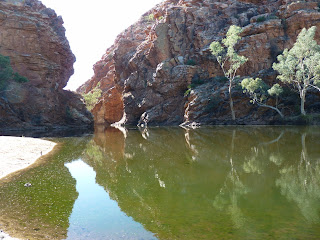I’d been really looking forward to these
places, and they did not disappoint. Both of them interesting and special in
their own ways. We were sad to leave them.
Just
quickly though, and worth a photo, we stopped here on the way…
Mataranka
Some
of you may have heard of the novel and movie ‘We of the Never Never’ – the
story of Jeannie Gunn. She went as a newly-wed, from Melbourne, in 1902 or so,
with her husband to Elsey Station, near Mataranka. It was rough ‘n’ tough back
then, and a man’s world where women were not welcome. Anyway, she fell in love
with the place, despite the hardship and isolation, kept a diary, from which
she developed a book. And the movie was made many years later. She said it was
‘Never Never land’ because once it got its hooks into you, you’d never never
want to leave. Anyway, Mataranka is known as the heart of Never Never land, and
it has lots of references to Jeannie’s story throughout the town. Elliot and I
loved it – it did feel kind of special.
Whilst
there, we enjoyed two of the thermal springs. We also saw our first wild crocs
in the Roper River – they were the first of many to come as we headed further
north. I think the 3 hours we spent at Bitter Springs was one of our highlights
of the trip so far. The colour of the water was like all colours (except
red/orange) of a blue opal, and crystal clear too. The water bubbles up at
about 30.5 million litres per day and is a consistent 34°C. It was completely
natural. We were surrounded by water lilies and reeds, and floated for about 10
minutes with the current along with the fish and turtles. Having snorkels with
us gave us a glimpse of the underwater world. We were blown away by this magic.
The
main pool of Bitter Springs, leading off to the creek whose current you could
drift along with.
Where
you climbed out, to walk back and do it all over again!
Happy
days!!
There
were water lilies in bloom everywhere.
Katherine
We
packed a lot into a couple of days here. Bushwalking, kayaking, an Aboriginal
cultural experience, and a Stockman’s dinner. The last three mentioned here, we
did all in the same day! It was a biggie, and a very memorable day. Awesome
again!
Nitmiluk
National Park and Gorge (formerly know as Katherine Gorge and NP) is a large
area. One big gorge, with lots of smaller ones joining it. It was stinking hot
when Elliot and I did a bushwalk to Butterfly Gorge, down to Nitmiluk Gorge. To
be honest, we weren’t majorly impressed by the walk, probably because the ones
we’d done at Kata Tjuta, Uluru, Kings Canyon and the MacDonnell Ranges had been
incredible. Oh to be spoilt eh?! We only splashed about in the gorge for a few
minutes, as we were still a bit scared about the possibility crocs would be
present, despite the waters having been declared safe for swimming. The day we
took a dip in the gorge was the first day it had been opened!
However,
the next day was one of my favourites so far, and very memorable. That was
where we did kayaking in the morning, followed by an Aboriginal Cultural
experience, then the Stockman’s dinner at night.
Kayaking:
We
went with the same family we’d met at Bitter Springs, and it was great company
for both of us. It was so nice to see Nitmiluk Gorge from water level, as
mostly you see gorges from lookouts, or you’re clambering over rocks along dry
river beds. I felt much more at ease about the crocs now, and enjoyed a couple
of swims too. The huge croc traps and baits along the river bank were
untouched, and I’d seen some kayakers come back safe before us, so at least I
knew we weren’t the ‘test run’!
Relaxed
and happy – who me?!
One of
the many lovely beaches along Nitmiluk Gorge. The crocs get the best
spots…(crocs had been removed by the way, but their nesting areas remain
protected)
Elliot
taking a break from kayaking. Gee, he looks pretty vulnerable in the middle of
the Katherine River on his own doesn’t he?
A
shallow tributary – so peaceful.
Cultural
Experience:
Next,
we headed towards Katherine town to do the ‘Cultural Experience’, and it was awesome!! Our Aboriginal guide was
Manuel, who first told us a brief story of his life, where he was born in a
‘humpy’ in the bush, surrounded by the traditional customary ways of life, and
didn’t see his first white man til he was about 7 years old (he was terrified
of him by the way – thought he was a ‘spirit’ come to get him). Manuel is a
very traditional Aboriginal man, and carries his traditions, stories and
cultural ways with him. He doesn’t know his birthday, and can only guess at his
age. Anyway, after a bit of storytelling, in that beautiful engaging way
Aboriginal people do, he played a bit of didgeridoo, then took us of to show us
how to light a fire with sticks. Then he showed us how to creep up on prey, and
how to throw a spear. Then, he taught us how to do a painting in the style of
people from the north/Kakadu/Arnhem Land, using traditional grasses and tools.
We learnt that the most important thing for a painting done by someone in his
tribe (Dalabon) is to have four white lines repeated at intervals when filling in the
middle of the design. Any more or any less than 4 would symbolise another
tribe. Traditionally only men would paint, but now women do it too. He said
that when he was learning to paint in early adolescence (part of the rite of
passage), if you did something wrong in your painting, particularly the 4 white
lines bit, your punishment would be a spear through the leg. I asked other
Aboriginal men about this punishment in subsequent tours, and they did exactly
the same thing. Similar punishment would also be dished out for swearing. ‘Where
did we go wrong in Western Culture?’, I asked myself??! But seriously, they
have an incredibly strong kinship system and strict laws of how to live (as
determined by Dreamtime), which they enforce without mercy. Anyway, we got
through our paintings without punishment, and reluctantly left Manuel. He’d
been fantastic – so patient, engaging, humerous, interesting and friendly. He
made a great impression on us both.
A
taste of the Aboriginal kinship system. This example is only the tip of the
iceberg – wait til you hear of who you’re allowed to marry because of your skin
name, and that you can actually be your own grandson or something! I got
totally lost, despite hearing about this over and over through the following
weeks! Mind boggling! And all to do with keeping blood lines clean and to stop
inbreeding. Aboriginal people has it right tens of thousands of years ago, like
so many other things in their culture.
Me
attempting to make embers through friction, to then throw onto the dried grass
in front of Manuel. It was hard work, and took about 4 of us tourists to have a
go before we succeeded!
Manuel
with fire sticks and a Woomera (multi purpose tool). The fire sticks are from
the Kurrajong tree, as it’s soft, and easily made into embers. The Woomera is
made of Ironbark – a very hard wood, and therefore won’t catch fire easily.
It’s used to catch the embers which are then tossed onto the grass. The other
highly significant tree Aboriginal people use is Paperbark. They use it to wrap
things up, like food, their newborns, their dead, to build canoes out of…the
list goes on. The fire sticks are kept, as each burn hole is a prompt for a
story eg, the 5th hole from the left is when so and so did such and
such, or when someone was born or died etc.
Manuel
teaching Elliot how to throw a spear. Again, the Woomera appears, as extra
leverage for spear throwing.
Manuel
is also an artist. This was his ‘step by step’ drawing board of how to do a
painting. Step 5 is the crucial one – the one where you need to put in your 4
white lines symbolising the ‘Dalabon’ tribe. This was the ‘spear through the
leg’ moment if you got it wrong!!
Me at
stage 3. Elliot (above me in pic) is on stage 4.
Elliot’s
finished painting.
And mine! Can’t wait to hang this above my desk at work.
Elliot
was really taken with ‘Maddie’ – an Agile Wallaby orphan joey. She was so
cute!!!
The
Stockman’s Dinner
Couldn’t
have chosen a better night for this after all the activity we’d done! Marksie,
the storyteller and chef, had his traditional camp kitchen set up in the
grounds of the ‘Outback History’ museum, and it looked beautiful.
And
between Marksie’s tales, this is what he served up, all of it cooked over a
campfire!! Takes
him about 8 hours every time he holds one of his dinners…
Entrée:
·
Crocodile and beef sausage roll with 4 vegetables and a bush tomato
seasoning topped with a desert quandong sauce.
·
Camel sausage with a mountain pepper seasoning and a bird's eye sweet
chilli
sauce
·
Wild Barramundi in a lemon myrtle and rainforest spice, served with a
fresh
mango salsa
·
Roast wattleseed cheese topped damper
Mains:
·
Roast Lamb in a wild rosemary and a 5 spice stemgrass
·
Roast Beef in a native pepperberry sauce
·
Roast Potato, Roast local pumpkin, Tomato and Onion
Bread crumb topped
pie (with grandma's secret "bomb")
·
Peas in Native Mint.
Desert:
·
Gem scones with native jam and fresh cream
·
Gum leaf billy tea
·
Non- alcoholic native jungle juice (native mint, forestberry herb,
native
lime juice, pineapple & water'
Quite astonishing, and absolutely sensational! Marksie has spent 12
years perfecting his recipes and cooking techniques, over such a variable heat
source. The other thing he did was infiltrate ‘women’s business’, as with the
vast majority of his ingredients being bush tucker, and seasonal, he had to
earn the trust and respect of the local Aboriginal ladies to learnt from them.
Now, he adapts their knowledge, and develops his own combos, tests it out on
the skeptical lades, who invariably absolutely love what he’s done.
Quite a special bloke (now well in his 60’s I think), and a wonderful
partnership he’s built up with them.
Returned back to camp, exhausted, but fully satiated, and smiling. What
a day!!
















































































